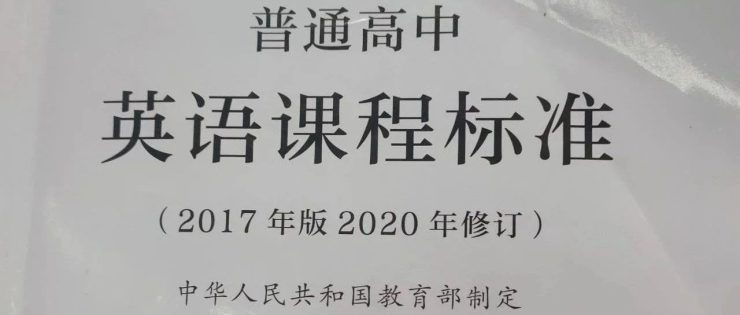【学习分享】《普通高中英语课程标准》(版订正)常用术语英语表达130条(一)


1. new curriculum
新课程标准
2. dominant carrier of information
信息的主要载体
3. cornerstone of quality education
素质教育的基石
4. develop strategies for basic education.
制定基础教育战略。
5. the current round of reforms
本轮改革
6. over-emphasize the transmission and explanation of knowledge about grammar and vocabulary.
过分强调语法和词汇学问的传递和解释。
7. develop students’ ability to use language for real.
培养学生实际运用说话的能力。
8. develop students’ comprehensive language competence.
培养学生的分析语言能力。
9. cognitive /ˈkɒɡnətɪv/ level
认知水平
10. Promote task-based teaching methods.
推广任务型教学方法。
11. Experiential, hands-on, participatory and collaborative learning
体验式、实践性、参与性和合作性学习
12. Develop students’ positive attitudes, thinking skills, practical abilities, cultural awareness and autonomy.
培养学生积极的态度、思维能力、实践能力、文化意识和自主能力。
13. Use language for real communication.
运用语言进行真实交际的能力。
14. all-round development
全面发展
15. Strengthen their interest in studying English.
加强他们学习英语的兴趣。
16. Grow in self-discipline, perseverance and self-confidence.
在自律、毅力和自信中成长。
17. Adopt good study habits and effective learning strategies.
养成良好的学习习惯和有效的学习策略。
18. Develop as autonomous and lifelong learners.
培养自主和终身学习者的能力。
19. Build moral integrity and a healthy outlook on life.
树立诚信和健康的人生观。
20. Enrich their life experience.
丰富他们的生活体验。
21. Promote quality education.
提倡素质教育。
22. Stimulate students’ interest in studying English.
激发学生学习英语的兴趣。
23. Foster students’ creativity
培养学生的创造力。
24. Learning Strategies
学习策略
25. Progress systematically
系统进展(学习)。
26. Curriculum objectives
课程目标
27. the teaching and learning process
教与学的过程
28. formative assessment
形成性评价
29. the assessment process
过程性评价
30. summative assessment
终结性评价
31. Teaching and learning resources
教学资源
32. Implement the curriculum.
实施课程。
33. Promote activity-based methods, experiential and participatory learning.
推广以活动为基础的方法,体验式和参与式学习。
34. hands on
亲自动手的,实习的
35. Adjust their learning strategies
调整学习策略。
36. Promote student’ development
促进学生发展。
37. autonomous learners
自主学习者
38. feedback
反馈
39. ongoing development and perfection of the English curriculum
不断发展和完善的英语课程
40. students’ integrated language skills
学生的综合语言能力
41. phonetics
语音
42. cross-cultural communication
跨文化交际
43. cognitive strategies
认知策略
44. metacognitive strategies
元认知策略
45. communicative strategies
交际策略
46. resource strategies
资源策略
47. Take the initiative to ask for help.
主动寻求帮助。
48. Identify cultural differences.
识别文化差异。
49. coherent and fully structured short compositions
连贯且结构完整的短文
50. Gather and process information effectively.
有效地收集和处理信息。
51. Consciously evaluate learning outcomes
有意识地评估学习成果。
52. Understand the cultural connotations and background.
了解文化内涵和背景。
53. Adopt a respectful and tolerant attitude towards cultures of different countries.
对不同国家的文化采取尊重和宽容的态度。
54. Expand and enrich learning resources autonomously.
自主拓展和丰富学习资源。
55. Use capitalization and punctuation with basic accuracy
正确使用大写和标点符号。
56. Extract information and viewpoints.
提取信息和观点。
57. Use contextual clues.
用上下文线索。
58. cause and effect structures
因果结构
59. Inquire for information
查询信息
60. Carry out situational dialogues
进行情景对话
61. word formation rules
构词规则
62. Deepen understanding of their own culture.
加深对自身文化的理解。
63. non-curricular reading material
课外阅读材料
64. extracurricular English learning activities
课外英语学习活动
65. audio visual materials
试听材料
66. Meet the diverse needs of all students.
满足所有学生的不同需求。
67. Provide students with ample opportunities to collaborate with others.
为学生提供充分的与他人合作的机会。
68. Give students plenty of space for self-development.
给予学生充分的自我发展空间。
69. Safeguarding their self-esteem and enthusiasm
维护他们的自尊和热情。
70. introverted students or weak learners
内向或学习能力较弱的学生
71. Establish a friendly and democratic channel of communication.
建立友好民主的沟通渠道。
72. Frequently reflecting on the learning process and results.
经常反思学习过程和结果。
73. Creatively design learning activities that are relevant to the students’ real lives.
创造性地设计与学生实际生活相关的学习活动。
74. Establish their own study targets and the means of fulfilling these
建立自己的学习目标和实现这些目标的方法。
75. Language and culture are closely related
语言和文化密切相关
76. Language is the main transmitter and carrier of culture.
语言是文化的主要传播者和载体。
77. Constantly broaden their cultural horizons
不断拓宽自己的文化视野。
78. Promote more individualized study
促进更加个性化的学习。
79. Students’ psychological characteristics
心理特点
80. Endeavor to become a creative and research driven teacher.
努力成为一名创新和研究驱动的教师。
81. Follow high frequency principles
遵循高频原则。
82. the curriculum standards
课程标准
83. implementation of the curriculum
课程实施
84. prompt feedback
及时反馈
85. the subjects (not objects) of assessment
评价主体
86. Clarify the direction in which they need to work.
明确他们努力的方向。
87. Everyday quizzes and tests
每天的小测验和测试
88. Avoid testing knowledge of phonetics or grammar in isolation.
避免孤立地测试语音或语法知识。
89. in a specific language context.
在特定的语言环境下
90. Avoid overly complex and time-consuming evaluation processes.
避免过于复杂和耗时的评估过程。
91. participation in role-plays
参与角色扮演
92. The basic information is still transmitted effectively.
基本信息仍然有效地传递。
93. Are the pronunciation, intonation and rhythm natural?
语音、语调和节奏自然吗?
94. A sense of a community of shared future for mankind
人类命运共同体意识
95. Deepen the understanding of the culture of our motherland.
加深对祖国文化的理解。
96. Strengthen patriotic feelings.
增强爱国情怀
97. Strengthen cultural confidence
坚定文化自信
98. Thinking quality
思维品质
99. core literacy
核心素养
100. Develop diversified and critical thinking
发展多元思维和批判性思维
101. Implement the fundamental task of establishing morality and cultivating people
落实立德育人根本任务
102. acquire, interpret and evaluate textual meaning.
获取、阐释和评判语篇意义。
103. Cross-cultural cognition
跨文化认知
104.international view/vision/perspective
国际视野
105. Transmit/spread Chinese culture.
传播中国文化
106. Absorb the essence of world culture.
吸收世界文化精华。
107. Elective Courses
选修课程
108. inquiry learning
探究性学习
109. English learning activity outlook
英语学习活动观
110. course plan
课程方案
111. Create an information-based teaching environment.
营造信息化教学环境。
112. Choose the right digital and multimedia tools.
选择恰当的数字技术和多媒体手段。
113. Ensure the application of new technologies such as virtual reality, artificial intelligence and big data.
确保虚拟现实、人工智能、大数据等新技术的应用。
114. Acquire cultural knowledge, understand cultural connotations, compare cultural similarities and differences.
获得文化知识,理解文化内涵,比较文化异同。
115.Sort out and summarize information.
梳理、概括信息。
116. Construct a new concept.
建构新概念。
117. creative thinking /pioneering/ innovative thinking
创新思维
118. multi-thinking
多元思维
119. Establish a correct view of English learning.
树立正确的英语学习观。
120. Thematic context
主题语境
121. Text type
语篇类型
122. Guided by the meaning of the theme.
以主题意义为引领。
123. Rely on the text.
以语篇为依托。
124. Create comprehensive, relevant and practical English learning activities.
创设具有综合性、关联性和实践性的英语学习活动。
125. credit
学分
126. oral and written text
口头和书面语篇
127. discontinuous learning material
非连续文本
128. Multimodal discourse
多模态语篇
129. Comprehension skill
理解性技能
130. Expressive skills
本文链接: https://www.yizhekk.com/0253343520.html








